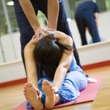Jacobson's relaxation technique
Jacobson's relaxation technique
Natural Standard Monograph, Copyright © 2013 (www.naturalstandard.com). Commercial distribution prohibited. This monograph is intended for informational purposes only, and should not be interpreted as specific medical advice. You should consult with a qualified healthcare provider before making decisions about therapies and/or health conditions.
Related Terms
Muscle relaxation, progressive muscle relaxation, relaxation response, relaxation therapy.
Background
Jacobson's relaxation technique, also called progressive relaxation therapy, and was developed by Dr. Edmund Jacobson over half a century ago. Jacobson developed over 200 exercises and techniques which, taken together, relax the entire body by releasing muscular tension that accumulates as a person experiences a stressful situation. Jacobson, and those who have followed in his footsteps, claim that this technique will cure not only tight muscles and cramps, but also reduces the intensity of pain, and relieve stress and anxiety.
Today, the 200 exercises developed by Jacobson have been reduced to between 15 and 20 exercises. In order to receive maximum benefit, it is recommended to practice this technique every day for at least 20 minutes at the same time every day in a quiet, comfortable place.
Jacobson founded the International Stress Management Association, which continues his work to this day. The International Stress Management Association (ISMA) produces publications and offers trainings in Jacobson's relaxation therapy.
Technique
This therapy involves initial tension followed by relaxation. For example, an individual may be instructed to choose a part of the body, and tighten the muscles in that area as much as possible for 7-10 seconds. Patients are asked to concentrate on the buildup of tension that occurs as the muscles are flexed in that particular area of the body for these seconds. After the 7-10 seconds have passed, the patient completely relaxes the area that was tightened. A patient would then wait about 15 seconds before moving on to another part of the body. It is recommended that all of the other areas of the body stay as relaxed as possible while concentrating on specific body parts or areas.
Theory/Evidence
Clinical research studies have generally shown that Jacobson's relaxation technique does indeed lessen muscle tightness, relax the patient, and reduces the patient's experience of pain.
A study published in Applied Psychophysiology and Biofeedback found that patients who practiced progressive muscle relaxation showed a decreased amount of cortisol, which typically increases during the body's response to stress.
In a 2001 study, this therapy was found to decrease anxiety and improve quality of life for patients recovering from heart attacks.
Another study, published in the Latin American Journal of Nursing, found that patients experienced a decreased sensation of pain after using this therapy. Though larger studies on this therapy are needed, the preliminary results of smaller studies are promising.
The exact mechanism that makes this therapy effective is not known.
Safety
Patients recovering from a physical trauma involving torn muscles or ligaments and patients recovering from broken or fractured bones should consult with their healthcare professional before using this technique.
Patients should not use this technique in a part of their body if they experience decreased, dulled, or absent sensation in that area.
Author Information
This information has been edited and peer-reviewed by contributors to the Natural Standard Research Collaboration (www.naturalstandard.com).
Bibliography
Natural Standard developed the above evidence-based information based on a thorough systematic review of the available scientific articles. For comprehensive information about alternative and complementary therapies on the professional level, go to www.naturalstandard.com. Selected references are listed below.
De Paula AA, de Carvalho EC, dos Santos CB. The use of the "progressive muscle relaxation" technique for pain relief in gynecology and obstetrics. Rev Lat Am Enfermagem. 2002 Sep-Oct;10(5):654-9. View Abstract
International Stress Management Association. 9 May 2006. www.isma.org.uk
Pawlow LA, Jones GE. The impact of abbreviated progressive muscle relaxation on salivary cortisol and salivary immunoglobulin A (sIgA). Appl Psychophysiol Biofeedback. 2005 Dec;30(4):375-87. View Abstract
Wilk C, Turkoski B. Progressive muscle relaxation in cardiac rehabilitation: a pilot study. Rehabil Nurs. 2001 Nov-Dec;26(6):238-42; discussion 243. View Abstract
Copyright © 2013 Natural Standard (www.naturalstandard.com)
The information in this monograph is intended for informational purposes only, and is meant to help users better understand health concerns. Information is based on review of scientific research data, historical practice patterns, and clinical experience. This information should not be interpreted as specific medical advice. Users should consult with a qualified healthcare provider for specific questions regarding therapies, diagnosis and/or health conditions, prior to making therapeutic decisions.
Updated:
March 22, 2017
